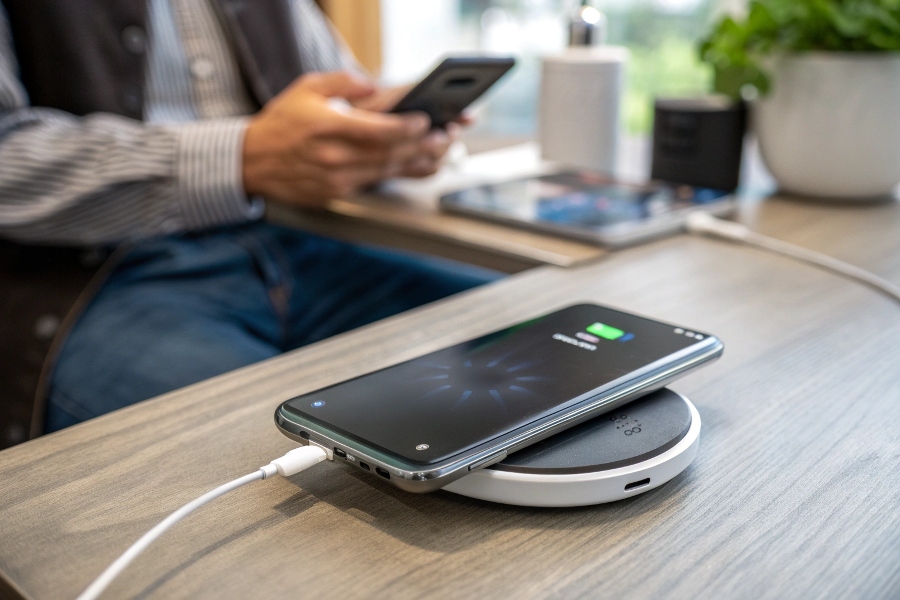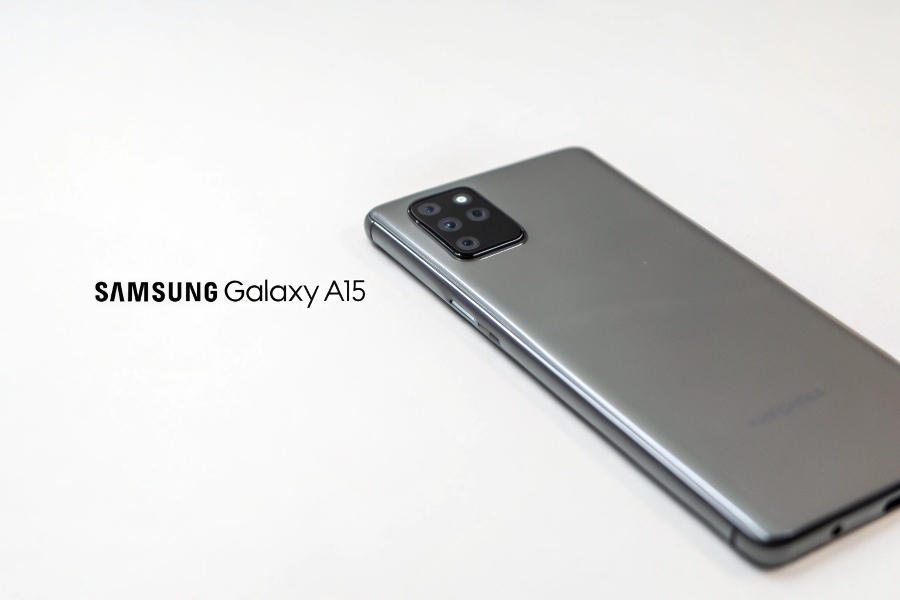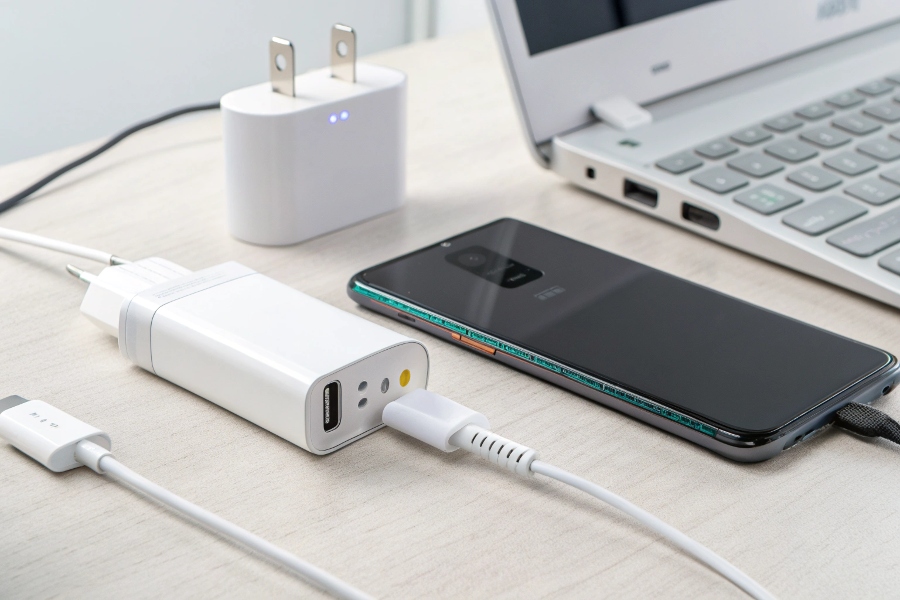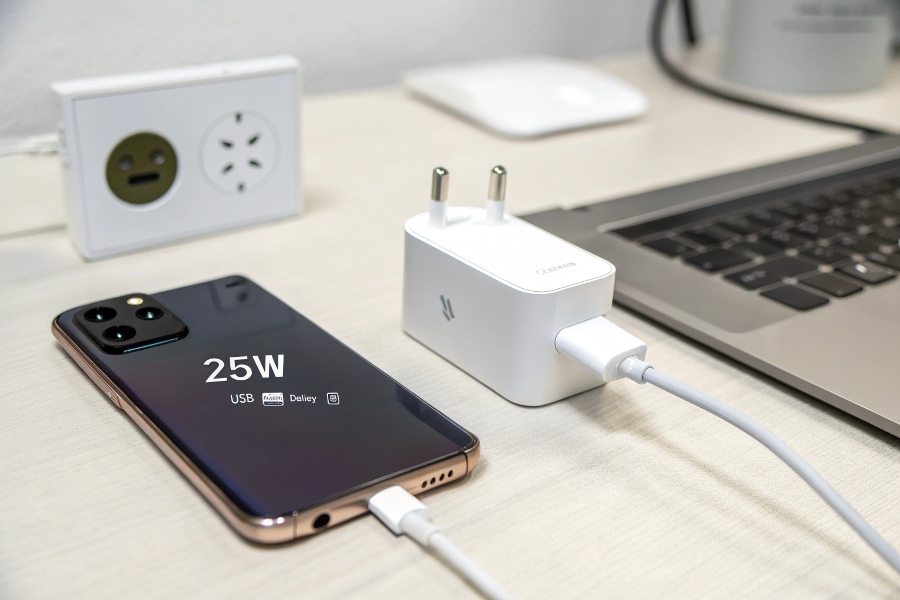Eyeing the affordable Samsung Galaxy A15? Tired of cables and wondering if this budget-friendly phone joins the wireless charging club so you can just drop it on a pad? Let’s get you the answer.
No, unfortunately, the Samsung Galaxy A15 (both 4G and 5G versions) does not have built-in wireless charging capabilities. This feature is typically reserved by Samsung for its higher-end Galaxy S, Note (historically), and foldable Z series phones.

Okay, so that’s a straight ‘no.’ But why doesn’t it have it, especially when wireless charging seems so common now? And what are your charging options then? As someone deep in the charger manufacturing world at FUMEI, understanding these feature decisions helps clarify the value proposition. Let’s explore why and what the A15 does offer.
Why doesn’t the Galaxy A15 include wireless charging?
Confused why a modern smartphone like the A15 skips this convenience? Worrying it might indicate other missing features or cut corners? Let’s understand Samsung’s strategy behind this decision.
It mainly comes down to cost and target market. Including the necessary internal coil and related circuitry for wireless charging adds to the manufacturing expense. To keep the A15 highly affordable, Samsung prioritizes essential features over premium conveniences like wireless charging.

Let’s dive deeper into the reasoning. Knowing this helps buyers like my friend David understand what they’re getting at different price points when sourcing electronics or choosing personal devices.
Keeping Costs Down
Adding wireless charging isn’t just about slapping a coil inside. It requires:
- The Receiver Coil: A precisely wound copper coil.
- Charging Circuitry: Components to manage the incoming wireless power and convert it safely for the battery.
- Shielding: Materials to protect other components from the magnetic field.
- Design Integration: Ensuring the coil fits without making the phone too thick or interfering with other parts.
- Licensing & Testing: Potential fees related to Qi certification and ensuring compatibility.
Each element adds cost. For a phone designed to be budget-friendly like the A15, omitting these helps Samsung hit that attractive lower price, making it accessible to more people.
Target Audience Priorities
Samsung knows that buyers looking at the A-series, particularly the lower-numbered models like the A15, are often prioritizing screen quality, battery life, camera basics, and overall value for money. While wireless charging is convenient, it’s often seen as a ‘nice-to-have’ rather than a ‘must-have’ for this market segment. Users might prefer the cost savings over the added feature.
Samsung’s Lineup Strategy
Samsung maintains clear distinctions between its phone lines.
- Galaxy A Series: Focuses on value, offering essential features and progressively more premium ones as you go up the model numbers (e.g., A3x, A5x sometimes get features lower models lack).
- Galaxy S Series & Z Series: These are the flagships, where Samsung includes its latest innovations and premium features, including faster wireless charging, water resistance, top-tier cameras, and more powerful processors. Wireless charging is standard here.
By reserving features like wireless charging for higher tiers, Samsung encourages upgrades and maintains the premium status of its flagship lines.
So, how does the Samsung A15 charge then?
Disappointed about the lack of wireless charging on the A15? Need to know what charging technology it does use so you can ensure you have the right cables and adapters? Let’s look at its wired charging specs.
The Samsung Galaxy A15 charges using its USB-C port and supports 25W wired fast charging1. This is actually quite good for a budget phone, allowing for relatively quick power-ups when using the right equipment.

While it lacks wireless, the A15 isn’t stuck with slow charging. Understanding its capabilities ensures you get the best experience. Reliable and fast wired charging is just as important as wireless, and something we focus on heavily at FUMEI.
Charging Specifications Breakdown
- Port Type: USB Type-C. This is the modern, reversible standard found on most new Android phones and many other electronics. No more fumbling to plug it in the right way!
- Maximum Charging Speed: 25 Watts (W). This is marketed by Samsung as "Super Fast Charging."
- Charging Standard: It typically relies on USB Power Delivery (PD) with Programmable Power Supply (PPS) support for optimal 25W charging. PPS allows the charger and phone to communicate for fine-tuned voltage and current adjustment, maximizing speed and efficiency safely.
What You Need for Max Speed
To actually achieve the 25W charging speed with your Galaxy A15, you need two things:
- A Compatible Charger: A wall adapter capable of outputting 25W via USB PD, specifically one that supports the PPS standard. Samsung sells its own 25W adapter, but many third-party USB-C PD chargers with PPS will also work. Using an older, lower-wattage charger (like 15W or the ancient 5W USB-A blocks) will result in slower charging speeds.
- A Compatible Cable: A USB-C to USB-C cable rated to handle the power. The cable that might come with the phone (if one is included) or any reputable USB-C cable designed for charging should work.
In-Box Accessories (Check Carefully!)
It’s becoming increasingly common for manufacturers, including Samsung, not to include a charging adapter in the box with new phones, especially budget models. You might only get a USB-C to USB-C cable, or sometimes nothing at all. Be sure to check what’s included when you purchase the A15, as you’ll likely need to buy a 25W PD PPS charger separately if you don’t already own one.
| Feature | Samsung Galaxy A15 Specification | Note |
|---|---|---|
| Charging Port | USB Type-C | Modern, reversible standard. |
| Max Wired Speed | 25W | Requires compatible 25W PD PPS charger and cable. |
| Wireless Charging | No | Feature omitted to reduce cost. |
| Charger In Box? | Usually No (Cable possibly included) | Check package contents; likely need separate purchase for 25W brick. |
So, while you miss out on wireless, the 25W wired charging is a solid feature for keeping the A15 powered up quickly.
Is there any way to add wireless charging to the A15?
Still really wish you could just drop your Samsung A15 on a charging pad? Frustrated by the lack of built-in support and wondering if there are any clever workarounds or accessories?
Yes, technically you can add wireless charging capability to the A15 using a third-party Qi wireless charging receiver adapter2. These thin adapters plug into the phone’s USB-C port and stick to the back, enabling charging on a standard Qi pad.

However, while these adapters exist, they come with significant trade-offs that might make them less appealing than just sticking with wired charging. Let’s explore how they work and their pros and cons.
How These Adapters Work
A Qi receiver adapter is essentially a small, flat pad containing a receiver coil and minimal circuitry, connected to a short ribbon cable with a USB-C plug.
- You plug the adapter into the A15’s USB-C port3.
- You carefully fold the ribbon cable and position the flat pad onto the back of the phone.
- You typically need to put a phone case over it to hold the adapter securely in place and protect it.
- Once installed, placing the phone (with the adapter) onto a Qi wireless charging pad allows the adapter’s coil to receive power and pass it through the USB-C port to charge the phone’s battery.
The Pros and Cons
Pros:
- Adds Wireless Convenience: It does allow you to charge the A15 by simply placing it on a Qi pad, achieving the cable-free experience.
Cons:
- Occupies the USB-C Port: The adapter continuously uses the phone’s only USB-C port. You’ll need to unplug it if you want to use wired charging, connect wired headphones (if supported), or transfer data via cable. This constant plugging/unplugging can be annoying and potentially wear out the port or the adapter’s plug.
- Slower Charging Speeds: Most of these adapters offer relatively slow wireless charging speeds, often limited to 5W, 7.5W, or maybe 10W at best – significantly slower than the A15’s native 25W wired charging.
- Adds Bulk & Awkwardness: The adapter pad adds a slight bulge to the back of the phone, which might affect how it fits in some cases or how it feels to hold.
- Case Compatibility Issues: You need a flexible case (like TPU or silicone) that can accommodate the adapter underneath. Rigid or very tight-fitting cases might not work well.
- Potential Reliability/Heat Issues: Cheaper, non-certified adapters might be less reliable, less efficient (generating more heat), or potentially unsafe.
Is It Recommended?
Generally, for most users, these adapters are not highly recommended due to the significant drawbacks, especially the occupied port and slower speeds. The added convenience often doesn’t outweigh the hassles. Unless you have a very specific need and are willing to accept the compromises, sticking with the A15’s capable 25W wired charging is usually the better, simpler, and faster option.
Conclusion
So, the final word: the Samsung Galaxy A15 does not have built-in wireless charging. It relies on its USB-C port for a respectable 25W fast wired charging, though you’ll likely need your own compatible adapter.
-
Learn about 25W wired fast charging technology and how it enhances charging speed for devices like the Samsung Galaxy A15. ↩
-
Discover how Qi wireless charging receiver adapters function and their pros and cons for adding wireless charging to devices. ↩
-
Explore this link to understand the benefits of USB-C ports, including their versatility and efficiency in modern devices. ↩
